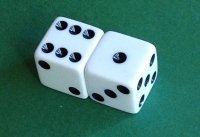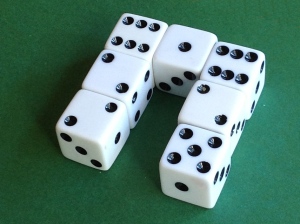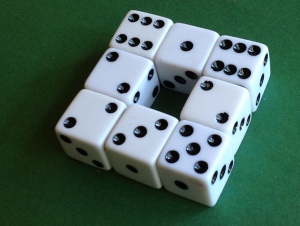Post by 1dave on Sept 13, 2020 16:54:49 GMT -5
a sphere has a single surface.
A torus has a single surface and a single "hole," so . . .
www.johndcook.com/blog/2012/10/30/euler-characteristic/
Euler characteristic with dice
Posted on 30 October 2012 by John
For any convex solid, V – E + F = 2 where V is the number of vertices, E the number of edges, and F the number of faces. The number 2 in this formula is a topological invariant of a sphere, called its Euler characteristic.
But if you compute the Euler characteristic for a figure with a hole in it, you get a different value. For a torus (the surface of a doughnut) we get V – E + F = 0.
You can demonstrate this with eight 6-sided dice. A single die has 8 vertices, 12 edges, and 6 faces, and so V – E + F = 2. Next join two dice together along one face.

two dice joined together
Before joining, the two dice separately have 16 vertices, 24 edges, and 12 faces. But when we join them together, we have 4 fewer vertices since 4 pairs of edges are identified together. Similarly, 4 pairs of edges are identified, and 2 faces are identified. So the joined pair now has 12 vertices, 20 edges, and 10 faces, and once again V – E + F = 2.
We can keep on adding dice this way, and each time the Euler characteristic doesn’t change. Each new die adds 4 vertices, 8 edges, and 4 faces, so V – E + F doesn’t change.

seven dice in a U-shape
But when we join the dice into a circle, the Euler characteristic changes when we put the last die in place.

eight dice in a torus shape
The last die doesn’t change the total number of vertices, since all its vertices are identified with previous vertices.
The last die adds 4 edges. It adds a net of 2 faces: it adds 4 new faces, but it removes 2 existing faces.
Exercise: Use a similar procedure to find the Euler characteristic of a two-holed torus.
A torus has a single surface and a single "hole," so . . .
www.johndcook.com/blog/2012/10/30/euler-characteristic/
Euler characteristic with dice
Posted on 30 October 2012 by John
For any convex solid, V – E + F = 2 where V is the number of vertices, E the number of edges, and F the number of faces. The number 2 in this formula is a topological invariant of a sphere, called its Euler characteristic.
But if you compute the Euler characteristic for a figure with a hole in it, you get a different value. For a torus (the surface of a doughnut) we get V – E + F = 0.
You can demonstrate this with eight 6-sided dice. A single die has 8 vertices, 12 edges, and 6 faces, and so V – E + F = 2. Next join two dice together along one face.

two dice joined together
Before joining, the two dice separately have 16 vertices, 24 edges, and 12 faces. But when we join them together, we have 4 fewer vertices since 4 pairs of edges are identified together. Similarly, 4 pairs of edges are identified, and 2 faces are identified. So the joined pair now has 12 vertices, 20 edges, and 10 faces, and once again V – E + F = 2.
We can keep on adding dice this way, and each time the Euler characteristic doesn’t change. Each new die adds 4 vertices, 8 edges, and 4 faces, so V – E + F doesn’t change.

seven dice in a U-shape
But when we join the dice into a circle, the Euler characteristic changes when we put the last die in place.

eight dice in a torus shape
The last die doesn’t change the total number of vertices, since all its vertices are identified with previous vertices.
The last die adds 4 edges. It adds a net of 2 faces: it adds 4 new faces, but it removes 2 existing faces.
So the net change to the Euler characteristic is 0 – 4 + 2 = -2.
The last die lowers the Euler characteristic from 2 to 0.
The last die lowers the Euler characteristic from 2 to 0.
Exercise: Use a similar procedure to find the Euler characteristic of a two-holed torus.














